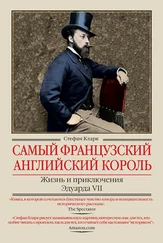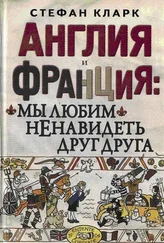Стефан Кларк - 1000 Years of Annoying the French
Здесь есть возможность читать онлайн «Стефан Кларк - 1000 Years of Annoying the French» весь текст электронной книги совершенно бесплатно (целиком полную версию без сокращений). В некоторых случаях можно слушать аудио, скачать через торрент в формате fb2 и присутствует краткое содержание. ISBN: , Издательство: Transworld Digital, Жанр: Старинная литература, на английском языке. Описание произведения, (предисловие) а так же отзывы посетителей доступны на портале библиотеки ЛибКат.
- Название:1000 Years of Annoying the French
- Автор:
- Издательство:Transworld Digital
- Жанр:
- Год:неизвестен
- ISBN:9781407067629
- Рейтинг книги:3 / 5. Голосов: 1
-
Избранное:Добавить в избранное
- Отзывы:
-
Ваша оценка:
- 60
- 1
- 2
- 3
- 4
- 5
1000 Years of Annoying the French: краткое содержание, описание и аннотация
Предлагаем к чтению аннотацию, описание, краткое содержание или предисловие (зависит от того, что написал сам автор книги «1000 Years of Annoying the French»). Если вы не нашли необходимую информацию о книге — напишите в комментариях, мы постараемся отыскать её.
1000 Years of Annoying the French — читать онлайн бесплатно полную книгу (весь текст) целиком
Ниже представлен текст книги, разбитый по страницам. Система сохранения места последней прочитанной страницы, позволяет с удобством читать онлайн бесплатно книгу «1000 Years of Annoying the French», без необходимости каждый раз заново искать на чём Вы остановились. Поставьте закладку, и сможете в любой момент перейти на страницу, на которой закончили чтение.
Интервал:
Закладка:
The North also did its bit to annoy William. In January 1069, the citizens of Durham killed the Norman occupiers (who had recently done a fair amount of massacring themselves). A few days later, York did the same thing, forcing William to come all the way up to Yorkshire in person to chase off the rebels and oversee the building of a new castle.
In September of the same year, a Danish force sailed up the Humber, supporting the claim of Edgar the Atheling to the English throne. Edgar and the Danes took York, with the unwitting aid of the Norman occupiers, who accidentally destroyed much of the city and their own forces when they set fire to the houses around the castle in an attempt to deprive the attackers of wood for siege machines.
William’s words when he heard that his own men had burnt the brand-new castle he’d had built are not recorded, but suffice it to say that he was very angry at these developments, so much so that the poor messengers who brought him the news of events in York were, as the French historian Paul Zumthor puts it, ‘mutilated’. Given that William frequently went in for punishments like castration, hand removal and blinding, it’s not pleasant to imagine what this might mean.
The King rode north again to sort out his new York problem. However, once he’d done this, he then had to go and deal with another revolt in Stafford, and as soon as his back was turned, there was another uprising in York, forcing William to gallop up there a third time, only to find that the rebels had done a disappearing act.
By now, William was very, very angry at these Anglo-Saxons who – just like Harold – kept breaking their oaths of allegiance to him, and he gave orders for a war crime that would today be punished by having the perpetrator locked away for several years in a comfortable prison complex in The Hague.
William told his army to kill and destroy everyone and everything in a band of territory running from Lancaster to York, from the North Sea to the Irish Sea, an area 180 kilometres by 70 kilometres. Exact records of the number of dead and displaced are hard to find, but chroniclers tell of whole villages preferring to hide in the forest and starve to death rather than face the swords of the Conqueror’s stormtroopers. The destruction was so massive and complete that the north of England remained a total wasteland for fifty years. 9
With so many people swearing oaths and then betraying him, William’s land-grabbing was getting terribly complicated. Disputes over who owned what, and who owed the rent from which lands to whom, became so frequent that in 1085, William summoned his best lawyers and accountants to an investment counselling conference in Gloucester. Even though almost everyone in England owed him a percentage of their income, he was really keen to know who they were and exactly what they earned, so that they couldn’t cheat him.
The answer the advisers came up with was that he should make a list of every bit of property, including human slaves – the serfs – in England. The resulting Domesday Book was as nerdy and completist as a trainspotter’s travel diaries.
In early 1086, surveyors were sent out, and when they had finished collecting their data, the information was double-checked by more surveyors. As well as being a register of everyone’s land, belongings and wealth, it also set the information out in feudal order, listing every fiscal debt, from the smallest landowners and absentee lords right up to King William himself.
The book’s name, given to it in the twelfth century, points to the sheer scale and importance of the project. There was so much information in there that people compared it to the Book of Life, the catalogue of deeds that God would consult when deciding everyone’s fate on Judgement Day.
And all this for a man who almost certainly couldn’t read. Perhaps William got a kick out of the sheer size of his pile of account books. Or maybe, now that he was almost sixty, he enjoyed having excerpts read to him at bedtime, to bring back memories of his younger conquering days.
‘Wait a minute. Bury St Edmunds, where’s that?’
‘You ransacked it on your way to Stafford, sire.’
‘Ah yes. And where’s this Chester you mentioned?’
‘You ransacked it on your way to Lancaster, sire,’ etc., etc.
The surveyors probably did their best to conceal the fact that there were gaps in the data, especially regarding property in London and the far North, which were troublesome areas where surveyors didn’t like to ask too many questions.
‘Didn’t I ransack a place called York? Why is that not in the book?’
‘York, sire? Oh no, no such town. Are you sure you read the signpost correctly? Or did you perhaps order the town to be completely obliterated?’
Another omission is even more revealing. Wine was the favourite drink of the Normans and especially of their Frankish colleagues, and forty-six vineyards are listed in the survey. However, according to the Domesday Book, only one of them (at Rayleigh Castle in Essex) was yielding a harvest. As William might have said, ‘Mon arse.’ Wine stocks were clearly not being listed by the Domesday surveyors, who seem to have been accepting liquid bribes to leave them out of the listings.
In any case, William didn’t have much time to enjoy his bedtime storybook, because he died in September 1087, soon after the survey was completed. And he did so in a way befitting a King of England – while bashing the French.
King Philippe I of the Franks had attacked Vexin, the part of Normandy that lies just northwest of Paris, and when William sent out messengers warning him to back off, Philippe, feeling confident now that the Conqueror was old and rather plump, replied, ‘When is the fat man going to have his baby?’
Despite his twenty-one years on the English throne, William still hadn’t acquired a sense of humour, especially where jokes about himself were concerned, so he decided to go and burn something French. His troops were storming the town of Mantes, just outside Paris, and William was enjoying a canter through its charred streets when, legend has it, his horse trod on a fallen beam, and he tumbled to the ground, causing himself serious internal injury.
It took him six weeks of terrible abdominal suffering to die, the pain no doubt made worse by the fact that his French doctors kept turning him over and trying to stuff plants up his backside – the aerodynamic, easy-to-insert suppository had not yet been invented.
The Anglo-Saxon Chronicle , the year-by-year historical annals written by Anglo-Saxon scribes, has a lot of fun with William’s obituary. A long insulting poem lists the hardship the Conqueror imposed in England:
His people he did bleed
Not from any need
Into avarice he did fall
And loved greed above all.
The monk writing the Chronicle even brings heavenly wrath to bear against William, saying that he died after destroying Mantes ‘and all the holy churches in the city’. The chronicler laments that ‘two holy men who served God were burnt to death’, and then describes with some relish how William subsequently suffered horribly and died, so that ‘he who had been a powerful king and lord of many lands now held no more than seven feet of earth’. It is the unmistakable sound of an English last laugh being had.
And the English probably weren’t the only ones sniggering …
William is victim of an elaborate stitch-up
The French often refer to the Bayeux Tapestry as ‘la tapisserie de la Reine Mathilde’, implying that the work was overseen by William’s wife. This is almost certainly wrong, though, and the name probably resulted from a kind of sexist assumption that embroidery must emanate from a woman rather than a butch man. Some say that it was commissioned by William’s brother Odo, largely on the basis that he and his close followers feature in the action and that the tapestry was first rediscovered in Odo’s abbey at Bayeux – though this last argument is a little like saying that a pharaoh’s sarcophagus was made in England because it is in the British Museum.
Читать дальшеИнтервал:
Закладка:
Похожие книги на «1000 Years of Annoying the French»
Представляем Вашему вниманию похожие книги на «1000 Years of Annoying the French» списком для выбора. Мы отобрали схожую по названию и смыслу литературу в надежде предоставить читателям больше вариантов отыскать новые, интересные, ещё непрочитанные произведения.
Обсуждение, отзывы о книге «1000 Years of Annoying the French» и просто собственные мнения читателей. Оставьте ваши комментарии, напишите, что Вы думаете о произведении, его смысле или главных героях. Укажите что конкретно понравилось, а что нет, и почему Вы так считаете.












